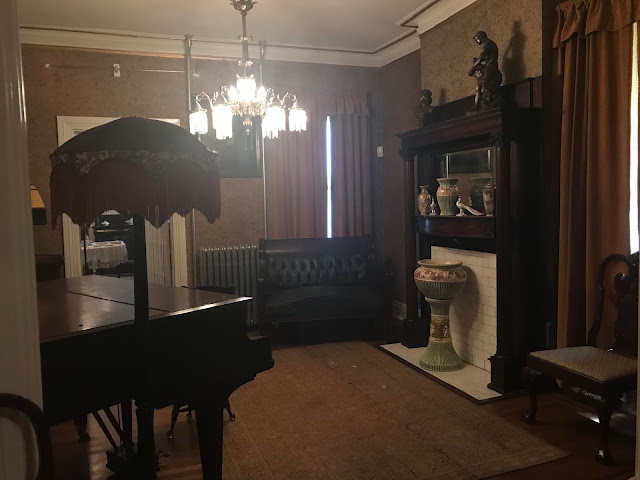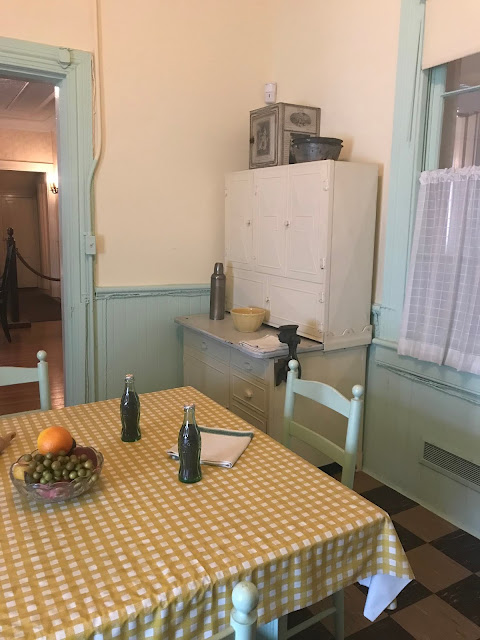To be honest, I had no clue who Maggie Walker was but before we left this location, I had a deep respect for her and I think it was everyone's favorite place of all the places we visited today.
Here's a fast time-line of who Maggie was:
- Born Maggie Lena Mitchell in Richmond, VA to Eccles Cuthbert Mitchell (a white man) and Elizabeth Draper (a black woman) on July 15, 1864 (just two months after the end of the Civil War). Her mom was a former slave; her father a butler and writer.
- In 1878, when Maggie was 14, she joined the local council of the Independent Order of St. Luke and administered to the sick and aged, promoted humanitarian causes and helped people gain self-help and integrity.
- She taught grade school for 3 years until 1886 when she married Armstead Walker, Jr. who was a brick contractor and leaves teaching. They had three sons, Russell (1890), Armstead (1893 but died at 7 months) and Melvin (1897). Maggie also fostered, Mary Anderson.
- In 1902, she published a newspaper "The St. Luke Herald" and chartered the St. Luke Penny Savings Bank where she was the 1st bank president. Later, she was chairman of the board when the bank merged with two other banks to become The Consolidated Bank and Trust Company that served as a Richmond African-American owned institution.
- June 20, 1915 - Her husband, Armstead was accidentally killed by her son Russell thinking he was an intruder. But, because of Maggie good sense, hard work and investments, she kept the family afloat. She always has a solution of every problem that came to her. She was a strong woman!
- Maggie Walker had multiple diplomas from schools and universities.
- When her sons married, they brought their wives to Maggie's home to live until they died, each of alcoholism. But, Maggie persevered.
- 1923, Russell dies from alcoholism - he never fully got over the fact he killed his father.
- In 1928 Maggie contracted diabetes, she created a wheelchair for herself and an elevator system in her house.
- Dec 15,1933 - Maggie dies and all of Jackson Ward celebrate her life and legacy.
- 1935 - Son Melvin dies of Pneumonia and Alcoholism.
- The home remains with the daughters-in-law.
- 1985 - NPS purchases the Maggie Walker Home from relatives along with near original furnishings and opens Maggie Walker NHS at her home.
- 2017 - Statue of Maggie unveiled on Broad Street in Richmond.
Maggie Lena Walker's home was right in the heart of Richmond, Virginia. She was a determined soul and devoted her life to civil rights advancements, economic empowerment and educations opportunities for Jim Crow-era (segregation) African Americans and women. She was the first female, black bank president, newspaper editor, and fraternal leader and inspired thousands of men and women. Her home has been preserved nearly intact as it was in her day as a tribute to her enduring legacy of vision, courage and determination (in part via NPS). The National Park brochure was most impressive about her life.
The visitor center is just around the corner and through the courtyard at 600 North 2nd Street. Parking is only found along city streets, so big rigs and RVers, please take note. Once we got to the visitor center, we watched the movie at Maggie Lena Walker in the visitor center and then began our tour. The visitor center is very small and houses an information desk, small bookstore and theater. Through the courtyard, you can see the side of Maggie Walker's home and garage.
Her home is located at 110 1/2 Leigh Street in historic Jackson Ward neighborhood.
 |
| Maggie's house is the red dot and we were also going just below that to the Richmond National Battlefield Park below... |
 |
| Our guide leads us out from the VC alley. |
 |
| We walk around the corner to Maggie's house with the green awnings. |
 |
| Plaque in front of her house. |
 |
| The entry way stained glass |
 |
| The front hall stairs |
 |
| Maggie's parlor - complete with all her pieces. |
 |
| Piano and furnishings. Maggie believed if you worked hard enough, you could have nice things and told people to always work hard and find solutions to your problems. |
 |
| Hunter worked on his Junior Ranger badge |
 |
| Maggie converted her favorite chair into a wheelchair when she had diabetes. This chair is a replica and not original to the other furnishings but looked exactly like Maggie's chair. |
 |
| This portrait of Maggie Walker above her wheel chair. |
 |
| Table in her study across from the Parlor. |
 |
| Maggie believed in education. |
 |
| Some of her diplomas... |
 |
| ...and more diplomas... |
 |
| ...and more. |
 |
| View of the front door from the back end of the house. |
 |
| The Dining Room |
 |
| All the fixings...the kitchen is beyond the door. |
 |
| Table in the Dining Room...the Parlor is through these doors. |
 |
| Dining Room Fireplace |
 |
| This is the narrow back addition. |
 |
| The kitchen table (leads to the Dining Room) |
 |
| More Kitchen. |
 |
| The Laundry Room |
 |
| More Laundry Room |
 |
| After Maggie contracted diabetes and couldn't walk, she added this elevator to her home. Prior to this her butler would carry her up the stairs. |
 |
| The back staircase by the kitchen and laundry rooms |
 |
| Upstairs hallway |
 |
| Storage Rooms |
 |
| Large Bedroom |
 |
| This is the Bathroom where Armstead was killed. He was climbing in through the window when Russell shot him. Originally below the window was a stairwell. |
 |
| Another Bedroom |
 |
| These Twin Guest Rooms... |
 |
| ...all led room through room with adjoining doors. |
 |
| Maggie's Bathroom...just the was it was when she died in 1934. |
 |
| Maggie's Sitting room. There is a door that leads to an adjoining enclosed porch overlooking the courtyard where the VC is located. |
 |
| Maggie's bedroom. |
 |
| The bed Maggie died in. |
 |
| Her fireplace and bureau. |
 |
| I loved this large photo hanging above her bureau. |
 |
| The curtains in her room. |
I would certainly recommend this national site to anyone visiting in the Richmond, Virginia area. All of us agreed that this was our favorite place to be!


















No comments:
Post a Comment